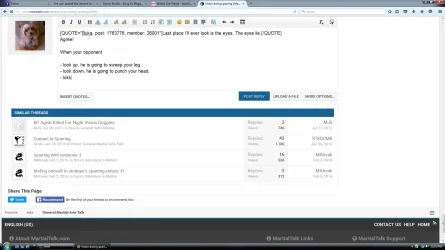This is interesting -- I've actually studied a bit of this in visual cognition (VC), a sub-field of psychology.
Basically, a lot of VC researchers study stuff that captures our attention, but it's usually with the aim of keeping our attention on one spot and avoiding distraction.
But that's not our goal here, right? We
want to be distracted by those limbs coming at our head. We
want them to capture our attention, so we can respond to them in time.
Long story short? If we focus on one spot, like the opponent's eyes, we reduce the ability of the opponent's attacking limbs to capture our attention, leading to a
delay in responding to them. We don't want that delay.
So, if we want to respond more quickly to those limbs, we need them to capture our attention. To do this, we need diffused or
unfocused attention. Or as they say in the field, we need to expand our "attentional window" to include the limbs that are likely to attack us. This is because the limbs are so far apart.
I wouldn't specify a
point of focus (e.g. the dan tien), because that would defeat the purpose. We don't want to focus on one point, we want a diffused, unfocused attention on the
whole person in order to be able to respond to those limbs that are spaced far apart. (... which agrees with what some of you guys are saying.)
Now, should we only expand the window to include the shoulders? Well, if you're
certain that shoulder moves indicate a punch, then maybe so. However, a smaller, more focused window makes it difficult to switch focus to a leg ... or maybe if we saw the left shoulder move, we would focus on it, which would shift our attention away from the right side, leaving us open to an attack from the right. I still think that going as wide and as unfocused as we can is best, as long as we train to be able to respond to subtle cues (e.g. shoulder) within that window. Learning to respond to subtle cues requires more training, to my mind.
I hope that makes sense.
(In VC terms, the attacking limbs might be called "abrupt onsets" and "exogenous cues," while the eyes might be an "endogenous cue" if we had chosen to focus on them.)
(Here's a
link. Look at the bottom half of the page that starts with "spotlight.")

